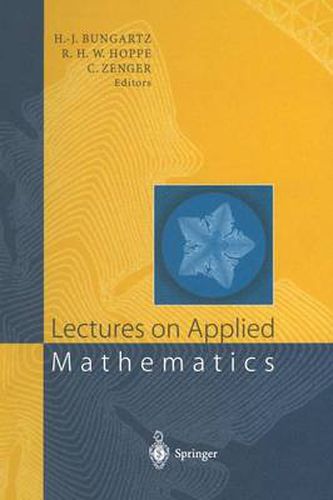Readings Newsletter
Become a Readings Member to make your shopping experience even easier.
Sign in or sign up for free!
You’re not far away from qualifying for FREE standard shipping within Australia
You’ve qualified for FREE standard shipping within Australia
The cart is loading…






This title is printed to order. This book may have been self-published. If so, we cannot guarantee the quality of the content. In the main most books will have gone through the editing process however some may not. We therefore suggest that you be aware of this before ordering this book. If in doubt check either the author or publisher’s details as we are unable to accept any returns unless they are faulty. Please contact us if you have any questions.
When the DFG (Deutsche Forschungsgemeinschaft) launched its collabora tive research centre or SFB (Sonderforschungsbereich) 438 Mathematical Modelling, Simulation, and Verification in Material-Oriented Processes and Intelligent Systems in July 1997 at the Technische Vniversitat Munchen and at the Vniversitat Augsburg, southern Bavaria got its second nucleus of the still young discipline scientific computing. Whereas the first and older one, FORTWIHR, the Bavarian Consortium for High Performance Scientific Com puting, had put its main emphasis on the supercomputing aspect, this new initiative was now expected to focus on the mathematical part. Consequently, throughout all of the five main research topics (A) adaptive materials and thin layers, (B) adaptive materials in medicine, © robotics, aeronautics, and automobile technology, (D) microstructured devices and systems, and (E) transport processes in flows, mathematical aspects play a predominant role. The formation of the SFB 438 and its scientific program are inextricably linked with the name of Karl-Heinz Hoffmann. As full professor for applied mathematics in Augsburg (1981-1991) and in Munchen (since 1992) and as dean of the faculty of mathematics at the TV Munchen, he was the driv ing force of this fascinating, but not always easy-to-realize idea of bringing together scientists from mathematics, physics, engineering, informatics, and medicine for joint efforts in modern applied mathematics. However, scarcely work had begun when the successful captain was called to take command on a bigger boat.
$9.00 standard shipping within Australia
FREE standard shipping within Australia for orders over $100.00
Express & International shipping calculated at checkout
This title is printed to order. This book may have been self-published. If so, we cannot guarantee the quality of the content. In the main most books will have gone through the editing process however some may not. We therefore suggest that you be aware of this before ordering this book. If in doubt check either the author or publisher’s details as we are unable to accept any returns unless they are faulty. Please contact us if you have any questions.
When the DFG (Deutsche Forschungsgemeinschaft) launched its collabora tive research centre or SFB (Sonderforschungsbereich) 438 Mathematical Modelling, Simulation, and Verification in Material-Oriented Processes and Intelligent Systems in July 1997 at the Technische Vniversitat Munchen and at the Vniversitat Augsburg, southern Bavaria got its second nucleus of the still young discipline scientific computing. Whereas the first and older one, FORTWIHR, the Bavarian Consortium for High Performance Scientific Com puting, had put its main emphasis on the supercomputing aspect, this new initiative was now expected to focus on the mathematical part. Consequently, throughout all of the five main research topics (A) adaptive materials and thin layers, (B) adaptive materials in medicine, © robotics, aeronautics, and automobile technology, (D) microstructured devices and systems, and (E) transport processes in flows, mathematical aspects play a predominant role. The formation of the SFB 438 and its scientific program are inextricably linked with the name of Karl-Heinz Hoffmann. As full professor for applied mathematics in Augsburg (1981-1991) and in Munchen (since 1992) and as dean of the faculty of mathematics at the TV Munchen, he was the driv ing force of this fascinating, but not always easy-to-realize idea of bringing together scientists from mathematics, physics, engineering, informatics, and medicine for joint efforts in modern applied mathematics. However, scarcely work had begun when the successful captain was called to take command on a bigger boat.